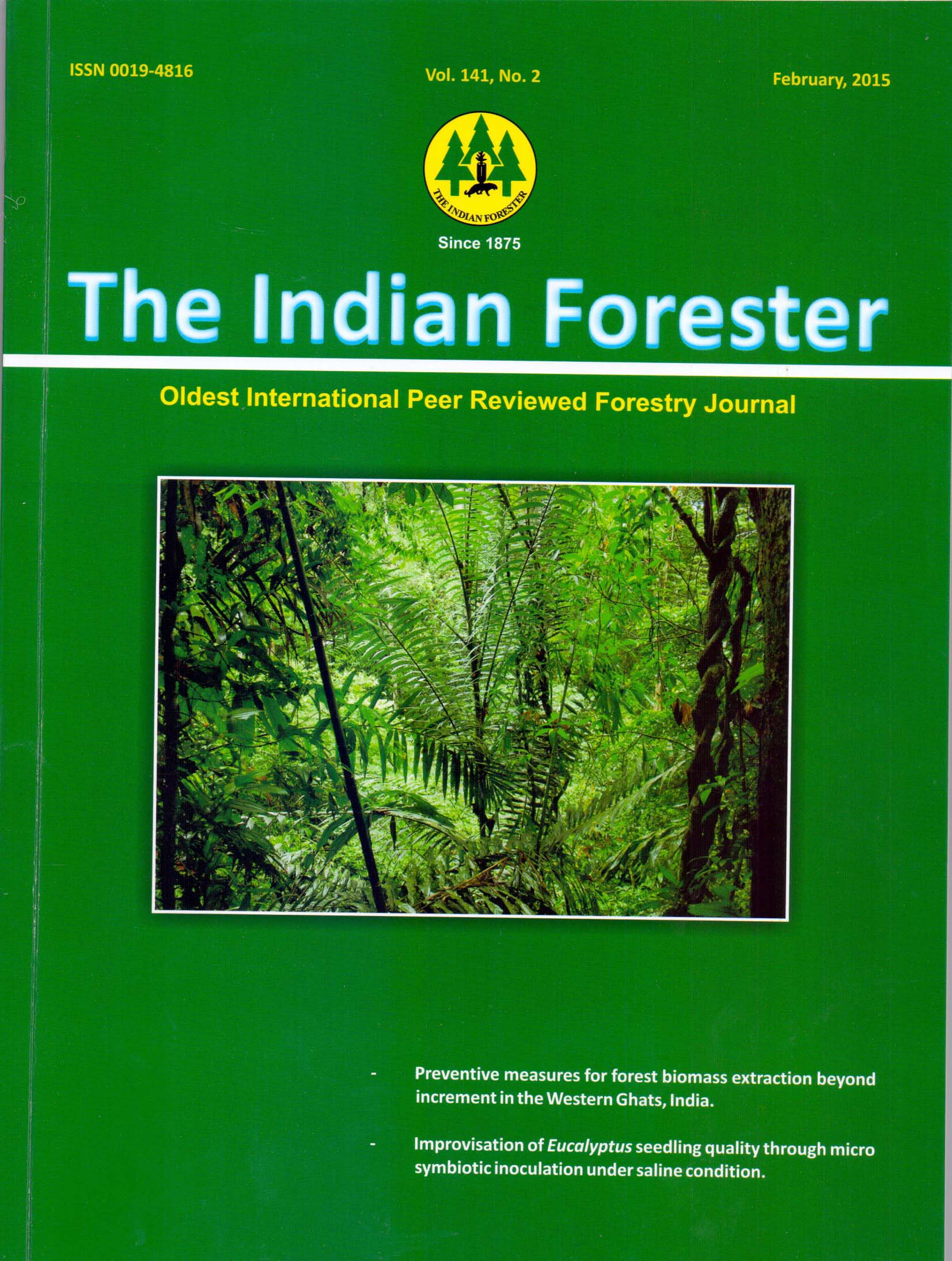Species-Provenance Variation in Growth, Stem Form and Wood Traits of Casuarina
DOI:
https://doi.org/10.36808/if/2015/v141i2/60687Keywords:
Casuarina, Provenance, Variation, South India.Abstract
Twenty provenances of six species of Casuarina (C. cristata, C. cunninghamiana, C. equisetifolia, C, glauca, C. junghuhniana, and C. obesa) were field tested for growth, stem straightness, bark, wood and fibre characters in Karunya, Tamil Nadu, India. Results obtained at 12 years ageshowedthat C. junghuhniana was the most adaptable and fastest growing species with 54% more volume production than the next ranking and widely cultivated species, C. equisetifolia. The SW Soe provenance of C. junghuhniana was the best provenance which recorded around 36% more volume than the species average and the best provenance of C. equisetifolia. The stem straightness was the best in C. cunninghamiana making it suitable for pole production. Bark thickness, wood density, moisture content and fibre traits varied significantly among species and provenances providing opportunity to select for different end uses like paper and fuelwood production. Since no adverse correlation was found between growth and wood traits, selections can be made independently for different traits. Testing of more provenances of C. cunninghamiana and C. cristata from northern latitudes and hybridization between species to combine desirable traits are proposed for effective utilization of genetic resources to increase plantation productivity.References
Amanulla B.K.M., Srinivasamurthy K.V., Chandra K.M.S., Pathak S.D. and Chandrasekaramurthy N. (2001). Variation in growth among Casuarina cunninghamiana provenances in Karnataka, India.In: Casuarina Improvement and Utilization (K. Gurumurthi, A. Nicodemus and Siddappa, Eds.), Institute of Forest Genetics and Tree Breeding, Coimbatore, India, pp 195-198.
Barlow B.A. (1983). The Casuarinas - a taxonomic and biogeographic review. In: Proceeding: Casuarina Ecology, Management and Utilization, International workshop, Canberra, Australia, 17-21 August,1981. CSIRO Division of Forest Research, Canberra.
Chonglu Z., Zhang Y., Chen Y., Jiang Q., Chen Z., Wu C., Pinyopusarerk K., Franche C. and Bogusz D. (2011). Casuarina research and th development in China. In: Proceeding: Improving Smallholder Livelihoods through Improved Casuarina Productivity, 4th International Casuarina Workshop, Haikou, China, 21-25 March 2010.
Doran J.C. (1983). Genetic resources of some Australian Casuarinas. In: Proceeding: Casuarina ecology, management and utilization, international Casurina Workshop, Canberra 17-21 August 1981.. CSIRO, Melbourne, Australia.
Doran J.C. and Hall N. (1983). Notes on fifteen Australian Casuarina species. In: Proceeding: Casuarina ecology, management and utilization, International Casurina Workshop, Canberra 17-21 August 1981. CSIRO, Melbourne, Australia.
Kamalakkannan R., Barthwal S., Chezhian P., Balasaravanan T., Yasodha R., Gurumurti K. And Ghosh M. (2006). Morphological and molecular diversity among Casuarina and Allocasuarina species. Biotechnology, 5:301-307.
Chavan R., Viswanath S., Shivanna H. And Tembhurne B.V. (2012). A phenological study of Casuarina species. Karnataka J. Agric. Sci., 25 (4): 455-459.
Nicodemus A. (2007). Genetic improvement of Casuarina equisetifolia through selection and breeding. ENVIS Forestry Bulletin, 7(1): 91-99.
Nicodemus A. Varghese M. and Nagarajan B. (2005). Selection of Casuarina junghuhniana Miq. Provenances for multiple end uses in India. In: Proceeding: Multipurpose trees in the tropics: Management and improvement strategies. Arid Forest Research Institute, Jodhpur, India, pp. 650-657.
Nicodemus A., Christi Sagaria Y., Kannan K., Rangarajan R., Mohanti A. and Gurudev Singh B. (2011). Production of inter-provenance and inter-specific hybrids of Casuarina equisetifolia and C. junghuhniana and their early evaluation for growth and form traits. In:Proceeding: Improving Smallholder Livelihoods through Improved Casuarina Productivity, 4th International Casuarina Workshop, Haikou, China, 21-25 March 2010.
Pinyopusarerk K. and House A.P.N. (1993). Casuarina: An annotated bibliography. ICRAF, Nairobi, Kenya. 298p.
Pinyopusarerk K. and Williams E.R. (2000). Range-wide provenance variation in growth and morphological characteristics of Casuarina equisetifolia grown in Northern Australia. Forest Ecology and Management, 143: 219-232.
Thirawat S. (1953). Note on Casuarina junghuhniana with special reference to its experimental introduction into India. Indian Forester, 79(12): 636-642.
Varghese M., Kamalakannan R., Nicodemus A. and Pinyopusarerk K. (2011). Fertility and progeny performance in seedling seed orchards of Casuarina equisetifolia and C. junghuhniana. In: Proceeding: Improving Smallholder Livelihoods through Improved Casuarina Productivity, 4th International Casuarina Workshop, Haikou, China, 21-25 March 2010.
Wang T.T., Yang J.C. Chen Z.Z. (1984). Identification of hybridity of casuarinas grown in Taiwan. Silvae Genetica, 33(4-5):128-133.
Williams E.R. and Matheson A.C. (1994). Experimental Design and Analysis for Use in Tree Improvement. CSIRO, Melbourne. PP 174.
Downloads
Downloads
Published
How to Cite
Issue
Section
License
Unless otherwise stated, copyright or similar rights in all materials presented on the site, including graphical images, are owned by Indian Forester.





